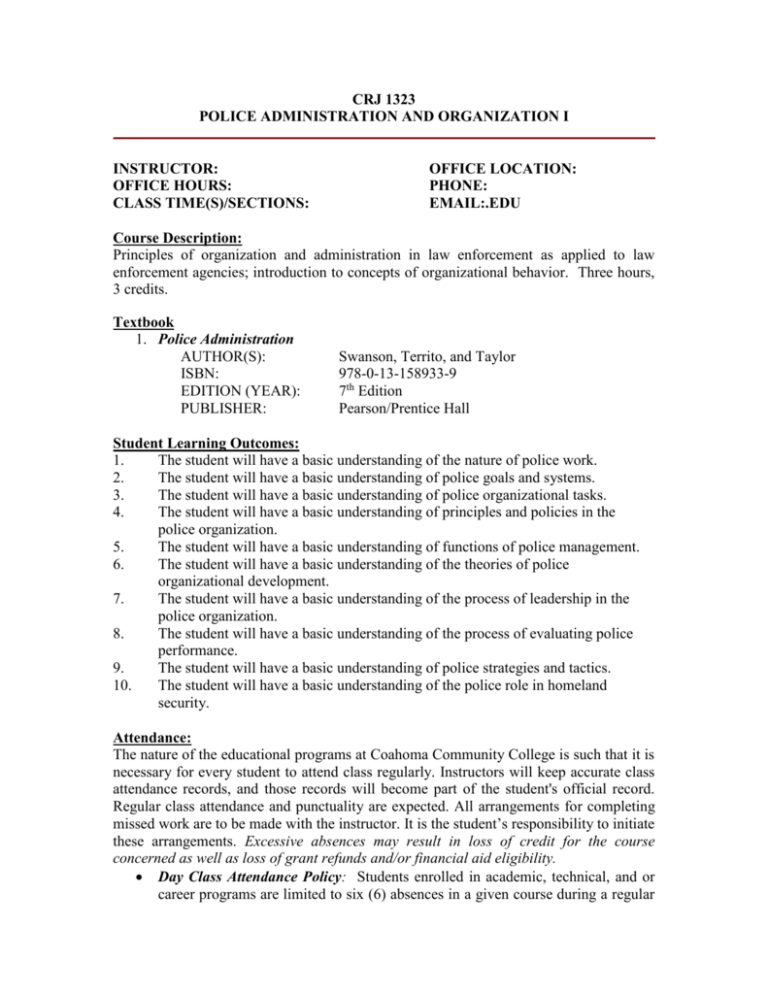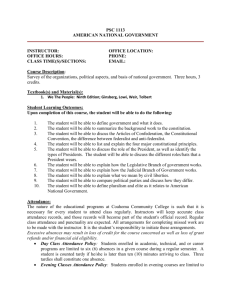
CRJ 1323
POLICE ADMINISTRATION AND ORGANIZATION I
INSTRUCTOR:
OFFICE HOURS:
CLASS TIME(S)/SECTIONS:
OFFICE LOCATION:
PHONE:
EMAIL:.EDU
Course Description:
Principles of organization and administration in law enforcement as applied to law
enforcement agencies; introduction to concepts of organizational behavior. Three hours,
3 credits.
Textbook
1. Police Administration
AUTHOR(S):
ISBN:
EDITION (YEAR):
PUBLISHER:
Swanson, Territo, and Taylor
978-0-13-158933-9
7th Edition
Pearson/Prentice Hall
Student Learning Outcomes:
1.
The student will have a basic understanding of the nature of police work.
2.
The student will have a basic understanding of police goals and systems.
3.
The student will have a basic understanding of police organizational tasks.
4.
The student will have a basic understanding of principles and policies in the
police organization.
5.
The student will have a basic understanding of functions of police management.
6.
The student will have a basic understanding of the theories of police
organizational development.
7.
The student will have a basic understanding of the process of leadership in the
police organization.
8.
The student will have a basic understanding of the process of evaluating police
performance.
9.
The student will have a basic understanding of police strategies and tactics.
10.
The student will have a basic understanding of the police role in homeland
security.
Attendance:
The nature of the educational programs at Coahoma Community College is such that it is
necessary for every student to attend class regularly. Instructors will keep accurate class
attendance records, and those records will become part of the student's official record.
Regular class attendance and punctuality are expected. All arrangements for completing
missed work are to be made with the instructor. It is the student’s responsibility to initiate
these arrangements. Excessive absences may result in loss of credit for the course
concerned as well as loss of grant refunds and/or financial aid eligibility.
Day Class Attendance Policy: Students enrolled in academic, technical, and or
career programs are limited to six (6) absences in a given course during a regular
semester. A student is counted tardy if he/she is later than ten (10) minutes
arriving to class. Three tardies shall constitute one absence.
Evening Classes Attendance Policy: Students enrolled in evening courses are
limited to three (3) absences in a given course during a semester. A student is
counted tardy if he is later than ten (10) minutes arriving to class. Three tardies
shall constitute one absence.
Summer School Attendance Policy: Students enrolled in summer courses are
limited to two (2) absences in a course during a summer term. Three (3) tardies
shall constitute one absence.
Health Science Programs Attendance Policy: Students enrolled in Health
Science programs are limited to one (1) absence for a one (1) semester credit hour
course; two (2) absences for a two (2) semester credit hour course; and three (3)
absences for a course receiving three (3) semester credit hours or more. Three (3)
tardies will be recorded as an absence. Absences greater than those listed above
result in the student being dropped from the course. Refer to the Health Science
Policy and Procedure Manual for further information.
Online Attendance Policy. Online classes are intended to accommodate the needs
of the individual student by allowing the student the convenience of attending
classes at the student’s discretion as long as the student completes and submits
assignments by the due dates. However, upon the third missed assignment, the
instructor may request that the student is dropped from the online class.
Make-up Policy:
Instructor is required to complete this section prior to presenting the syllabus to the
students at the beginning of each semester.
Academic Dishonesty:
Cheating and plagiarism (the representation of someone else’s work as your own, usually
by directly copying or paraphrasing without a reference to the original source) will not be
tolerated. The penalty will be receiving a (0) for that assignment, without any possibility
of make-up work or alternative assignments. Additionally, according to the Student
Handbook, Such acts will be considered a severe infraction and carry a possible sanction
of suspension in semester (s) length or expulsion. For a more in-depth explanation of
academic dishonesty, see the Student Handbook.
Electronic Devices in Class:
The use of cellular phones, pagers, CD players, radios, and similar devices is prohibited
in the classroom and laboratory facilities.
Non-Discrimination/Disability Policy:
Notice of Non-discrimination. Coahoma Community College does not discriminate on
the basis of race, color, national origin, sex, disability, or age in its programs and
activities. The institution has designated a Section 504/ADA/Title IX Coordinator.. To
address inquiries regarding the non‐discrimination policies, please contact Wanda
Holmes for more information at 662-621-4853.
Accommodations for Students with Disabilities. Coahoma Community College is
committed to ensuring equal access to an education for enrolled or admitted students who
have verified disabilities under Section 504 of the Rehabilitation Act of 1973 and the
Americans with Disabilities Act of 1990 (ADA). College policy calls for reasonable
accommodations to be made for eligible students with verified disabilities on an
individual and flexible basis.
Any student enrolling in Coahoma Community College with a documented disability,
who requests accommodations, must first provide a current evaluation of the disability
from a medical professional. This documentation, which is required by federal guidelines,
will remain on file with the Section 504/ADA/Title IX Coordinator, Wanda Holmes, 662621-4853.
Instructional Techniques:
Instructor is required to complete this section prior to presenting the syllabus to the
students at the beginning of each semester.
Method(s) of Evaluation:
Instructor is required to complete this section prior to presenting the syllabus to the
students at the beginning of each semester.
(Method(s) of evaluation must measure the student learning outcomes listed above.)
Grade Scale:
Coahoma Community College changed from the 3.0 system to the 4.0 system effective,
September, 1974. College students' academic progress is evaluated according to the
following grading system.
GRADE
A – Excellent
B – Good
C – Average
D – Poor
F – Failure
SCALE
90-100
80-89
70-79
60-69
Below 60
QUALITY POINTS
4.0
3.0
2.0
1.0
0.0
To be in good academic standing, students are required to maintain a cumulative 2.0
average on the 4.0 system. Each grade reported as having been earned by the student at
the end of a semester or summer term will be included in computing the cumulative grade
point average. The student should observe that the grade “F” carries zero quality points
and will be included in the computation. For more information on the Coahoma
Community College Grade Scale, students should see the College Catalog.
CRJ 1323- POLICE ADMINISTRATION AND ORGANIZATION I
COURSE OUTLINE
This outline is intended as a guideline for the course. The institution and the instructor
reserve the right to make modifications in content, schedule, and requirements as
necessary to enhance each student’s educational experience and student learning
outcomes.
I. Historical Development
A. Politics and Administration
B. Police Professionalization
II. Policing Today
A. Community Policing
B. Policing and New Information Technologies
III. Intelligence, Terrorism, and Homeland Security
A. Terrorism and Intelligence-Led policing
B. Political Violence and Terrorism
IV. Politics and Police Administration
A. Police Accountability
B. The Roles of State and Local Government in Law Enforcement
V. Organizational Theory
A. Traditional Organizational Theory
B. Bridging Theories
VI. Organizational Design
A. Organizational Structure and Design
B. Types of Organizational Design
VII. Leadership
A. Leadership and Performance
B. Theories of Leadership
VIII. Planning And Decision-Making
A. Planning Approaches
B. Ethics and Decision Making
IX. Organizational Communication
A. The Communication Process
B. Communication Barriers
X. Human Resource Management
A. Functions of the Human Resource Management Unit
B. The Police Personnel Selection Process
XI. Labor Relations
A. The Unionization of the Police and Its Impact
B. Grievances
XII. Financial Management
A. Politics and Financial Management
B. Supplementing the Police Budget: Tactics and Strategies
XIII. Stress And Police Personnel
A. Stress in Law Enforcement
B. Police Suicide
XIV. Legal Aspects Of Police Administration
A. Liability for Police Conduct
B. Scope of Liability
XV. Organizational Change and The Future
A. Two Organizational Change Models
B. Politics and Organizational Change










